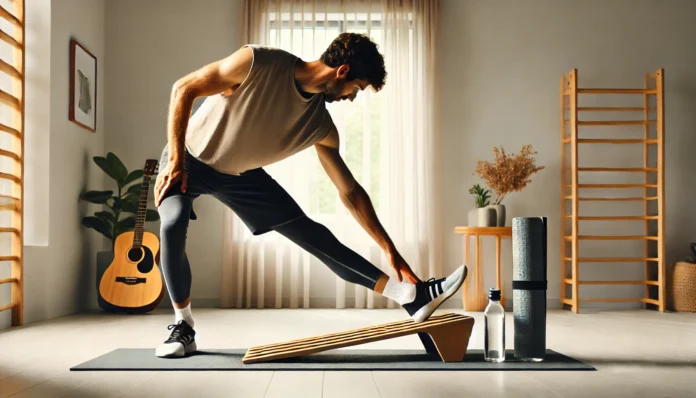Generally, people assume that the slant board is too hard to use, while in fact, it is a valuable device that can facilitate stretching, enhance agility, and prevent injuries. Whether you are an athlete, an exercise enthusiast, or someone recovering from an injury, understanding how to use a slant board properly can significantly impact your performance and overall well-being. In this guide, we will explain the highly beneficial ways to use a slant board for stretching, muscle building, and recovery, helping you maximize its advantages to the fullest.
What is a Slant Board?
A slant board is an inclined platform designed for stretching, rehabilitation, and strength exercises. It is most typically used for:
- Calf and Achilles tendon stretching
- Ankle and knee mobility improvement
- Squat support for straight form better
- Getting rid of plantar fasciitis and reducing knee pain level
Okay, now let’s dissect the right way to use a slant board.
How to Use a Slant Board for Different Exercises
Calf Stretch
Calf stretching is a conventional way of using the slant board which is effective in stiffness and risk avoidance.
Steps to Follow:
- Standing on it with your heels on the slant board supposed to be lower than your toes.
- Keep your legs relaxed and keep your posture well.
- Move forward little by little to stretch the calf muscles.
- 20-30-second break followed by relaxation.
- Repeat twice or thrice.
💡 Tip: Change your flexibility to meet the slope adjustment.
Also Read: How Is Therapy Like a Lighthouse
Squats on a Slant Board
The act of doing squats perpendicular to a slant board would be very beneficial for the locking of knees and quadriceps conditioning the muscles.
Steps to Follow:
- Put them a little wider from the shoulder on the slant board.
- Your back should be straight, and your stomach be contracted throughout.
- Now bend your lower part as if you were sitting on a chair and make your knees stay in a 90-degree position to your toes.
- Stay down for one count and then you can rise back to your initial spot.
- Do around 10 to 15 circuits.
💡 Tip: On the other hand, if you are a beginner, use a smaller slant to improve your balance.

Plantar Fasciitis Relief Stretch
See what using a slant board for plantar fasciitis can do for you if you’re experiencing heel pain.
Steps to Follow:
- In the slant board stand with your feet about the width of your shoulders.
- Make a slight bend in your knees to activate the foot arch.
- Now, count to 30 seconds then, release the position.
- Perform each one 3-4 times every day, in the most effective way possible.
Ankle Mobility Drill
A slant board is a perfect tool to help athletes increase their ankle stretching ability.
Steps to Follow:
- One foot should be placed on the slant board, while the other should be placed on the floor.
- Lose back side plus forward your foot and back again to perform this exercise.
- Do 10 times for each foot.
💡 Tip: Move at a snail’s pace to prevent ankles from being forced.
Key Benefits of Using a Slant Board
✅ Improves flexibility – This method means the induction of acute muscle extensibility which is achieved with different stretching techniques.
✅ Decreases the chance of injuries – Hardens the leg and joint muscles and thereby, prevents trauma.
✅ Lowers the risk of knee pain – This is a high quality strategy to treat people dealing with patellar tendonitis.
✅ Welds proper squatting mechanism – Will help you find the right angle with less effort and get that control of your pelvis stabilizer muscles.

Safety Tips When Using a Slant Board
🔹Start with a low incline – If you are a complete beginner, first try with 15 to 30 degrees.
🔹 Don’t forget to use grip-resistant shoes – That keeps you safe from taking a fall while you are on the move.
🔹 You must stop exercising if you feel any kind of pain – You should avoid pushing the areas that cause unpleasantness and pain.
🔹 Use it often – Apply this everyday so you can see a hot deal of improvement of your tight knee joints.
Final Thoughts
If you are familiar with a slant board, you can start incorporating it into your workouts to enhance comfort, relieve pain, and improve strength conditioning. Whether you’re using it for stretching, rehabilitation, or athletic performance, consistency is key to seeing results. Understanding how to use a slant board properly allows you to target specific muscle groups effectively, helping with flexibility, balance, and joint stability. Whether you’re performing squats, calf stretches, or ankle mobility exercises, maintaining a regular routine will maximize the benefits, reduce the risk of injuries, and support overall muscle recovery and endurance.
Slant boards are low cost and versatile, so use one today and find out the positive effects for yourself! 🚀
FAQs
Q. How often should I use a slant board?
Use it every day for stretching, and 2-3 times a week for strengthening exercises would be the most preferable.
Q. Can I use a slant board for knee pain?
Yes! One of the ways to use a slant board effectively for knee pain is to keep the quads muscles strong. This, in turn, will help reduce strain on the knees.
Q. Is a slant board good for plantar fasciitis?
Definitely! Practicing with it is a fabulous way of stretching the Achilles tendon and foot arch which are the main reasons for the heel pain.
Q. Can beginners use a slant board?
Yes! They should start at a low incline and then gradually increase the incline.
Q. What is the ideal incline for a slant board?
A 15-20 degree incline is the best one for a course, while advanced people can go to 30-45 degrees.
Also Read: Journal of Telemedicine and Telecare


